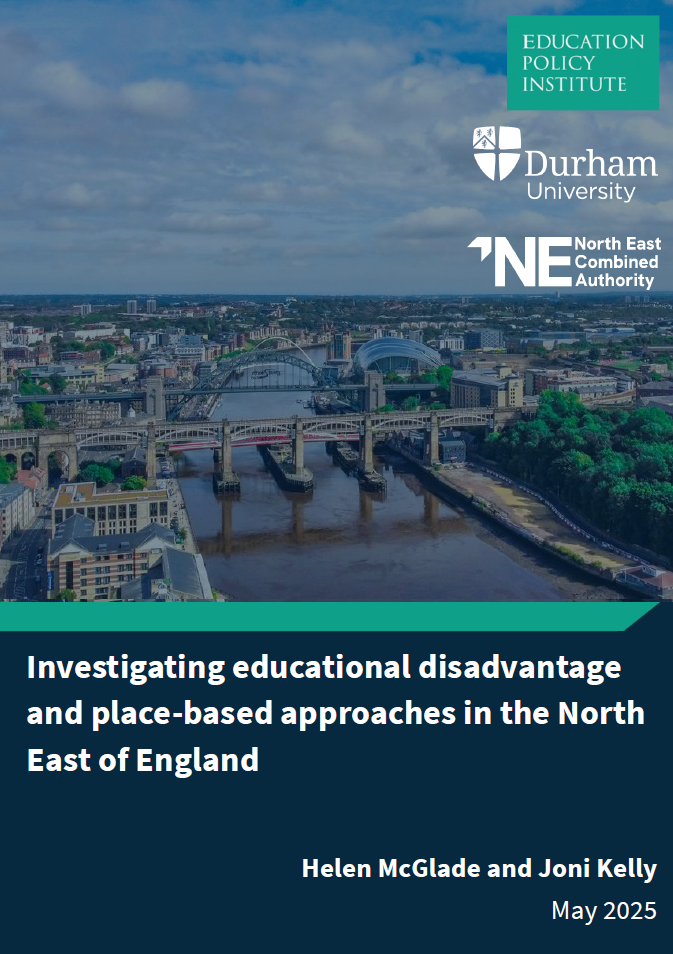In Spring 2025, EPI, in partnership with Durham University and the North East Combined Authority (NECA), brought together policymakers, school leaders and sector experts in a series of events investigating potential drivers of geographic educational inequalities and their implications for place-based policy using the North East Combined Authority area as a case study.
The series included three roundtables: the first looked at understanding and acting on the drivers of regional inequalities in the North East; the second focused on the role of local partnerships in addressing these gaps and the third and final event considered what the findings of the first two discussions meant for place-based policy, both at a local and national level, building on EPI’s analysis of geographic disparities, Durham University’s research base and NECA’s intentions and policy resource to make meaningful change in the region.
This paper draws together reflections from the wide-ranging discussions, touching on issues felt across England; the extent to which they are felt more acutely in the North East and some which are specific to the region and offers participant recommendations for how to improve education for pupils and staff in the North East. More widely, the paper also discusses the opportunities presented by the move towards further devolution and how place-based policy might offer solutions to the challenges identified.
The paper is available here.
Educational inequalities in the North East of England
- There is significant disadvantage in the North East. Children growing up in the region have a lower life expectancy, are more likely to be born into disadvantaged contexts, are more likely to perform poorly in secondary education, are more likely to become NEET (not in education, employment, or training) and are more likely to experience child poverty.
- In education, by the end of Key Stage 4 the disadvantage gap in the North East was 21.6 months, above the national average of 19.2 months. This is despite the NE having a smaller gap at the end of primary school (of 9.5 months) than the national average (10.3 months).[1]
- However, this is not a question of poor institutions. The North East does well compared to other regions with similar levels of disadvantage in terms of inspection outcomes and is particularly successful in attracting and developing high-performing school leaders in comparison to other regions.
- That said, there remains much work to be done to address the educational and wider inequalities in the region.[2][3]
Factors outside of education
- Participants highlighted that challenges in the provision of wider services make closing the disadvantage gap harder, including the inconsistent observation of the 2-year development check; national and local funding cuts and limited and expensive transport, citing examples of young pupil choosing which further education college to go to depending on whether they could get there by bus.
- Overall, schools in the region are providing extensive non-educational support services to families living in poverty and there was significant concern that in a tighter fiscal climate, this crucial support might be further reduced, undermining educational efforts.
Challenges within schools
- There are also challenges within schools that affect the experiences and outcomes of children and young people, including a lack of resources; difficulties recruiting and retaining teachers, particularly in disadvantaged schools; and struggles with literacy.
- Many participants felt that the accountability system is having detrimental impacts on the system, including a narrowed curriculum offer, deskilling of teachers and leaders and disincentives for inclusive practice. It was felt that in the current system, it takes significant bravery to run a school in the best way for its staff and pupils, as opposed to meeting inspection standards.
- Participants recognised that Ofsted is currently reviewing its inspection measures and there may be change for the better in future. For this to be the case, it was felt that doing well on attainment and being inclusive cannot be at odds with each other.
- School absence was also identified as a critical issue, mirroring national trends.
Supporting vulnerable pupils
- SEND provision was identified as the “biggest challenge of our time” with research shared showing increasing academic achievement gaps over time for most SEND categories in reading, writing and maths.[4]
- Participants called for greater collaboration between local multi-academy trusts and local authorities concerning vulnerable pupils, with trusts taking on more responsibility for inclusion and, when a pupil is excluded, remaining involved while a decision is made over where the child goes next, with the support of the LA.
Potential solutions
- Reflecting many national issues, areas identified for greater support at the regional level included more training and CPD for teaching assistants (TAs) and school leaders; a more well-defined collective understanding of inclusion and a greater focus on attendance and how to ensure children can re-engage with school, particularly those with the highest rates of absence.
- Regarding disadvantage, it was strongly felt that measures aiming to end segregation by socioeconomic status should be introduced, spreading the disadvantaged pupil population more evenly across schools.
- Participants also highlighted the value of partnerships with institutions outside of schools including local colleges, universities and third sector organisations.
Further research
- Participants called for further research to investigate and identify high-quality local practice and how this can be scaled up within the region and shared with other areas.
- The combined authority, with its links to LAs, trusts and schools, has a significant opportunity to develop, test and lead evidence generation that can inform school practice, local and national policy.
We are grateful to Durham University and the North East Combined Authority for supporting this work and to all participants for their contributions.



